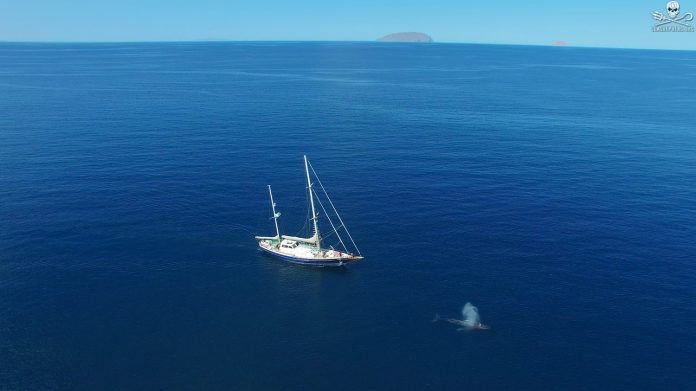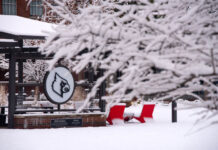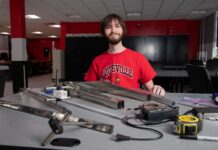
Professor John Pierce Wise Sr., PhD, met a blue whale for the first time in 18 years of marine mammal research. Here he shares the experience and video of the event.
In April, John Pierce Wise Sr., PhD, spent two weeks on a lab-equipped sailboat in the Sea of Cortez collecting tissue samples from free-ranging whales to be tested for chromium, mercury, silver and other toxic metals. He began this research in 1998, and since that time, has embarked on more than two dozen marine research expeditions. This spring’s trip included an experience Wise had hoped for since before he began his research: His team encountered a blue whale.
“When I started, and back even further, the whale I most wanted to see and study
was the blue whale. Yet, try as I might, blue whales always seemed
just out of my reach. … each time I went near the sea, be it on boat or land,
I hoped I would see one of these magnificent creatures.
Today was finally the day.”
— John Pierce Wise Sr., Blog post, April 6, 2016
A professor in the UofL School of Medicine Department of Pharmacology and Toxicology, Wise is a leading authority on metal-induced cancer development. He studies the cellular and molecular mechanisms of cancer and investigates the health impacts of chemicals in the environment, comparing their effects in humans with wildlife such as whales, sea turtles and alligators. Through this research, he hopes to better understand whether these pollutants cause DNA damage and cancer in marine life and in humans.
During this trip, Wise and his team of researchers obtained skin and blubber samples from 29 whales of seven different species in the Sea of Cortez, which lies between the Baja peninsula and the mainland of Mexico, emptying into the Pacific Ocean. On this project, Wise is collaborating with Sea Shepherd Conservation Society and Jorge Urbán Ramírez, PhD, at the Universidad Autónoma de Baja California Sur in Mexico. Wise’s son, John Jr., (Johnny) a graduate student in toxicology at Purdue University, and other team members used a crossbow to shoot a small dart into the whales’ skin from the vessel to obtain thimble-sized tissue biopsies without disrupting the animals’ activity. These crossbow handlers are known as biopsiers.
Following is Wise’s blog describing the encounter with the blue whale:
Wednesday, April 6, 2016 – Day 5 at Sea
I started developing my whale research in 1998. Hard to believe 18 years have passed as those first days seem like yesterday. I’ve worked on many species from whales to sea lions to sea otters to polar bears. Shoot even humans are considered marine mammals for that matter and we work on them too. But going back to when I started, and then back even further, the whale I most wanted to see and study was the blue whale. Yet, try as I might – blue whales always seemed just out of my reach. We worked on blue whale cells when a colleague gave me a sample. Still, each time I went near the sea, be it on boat or land, I hoped I would see one of these magnificent creatures.
Today was finally the day.
The day started with a couple of pods of short finned pilot whales – very cute whales travelling in a small group. We managed three biopsies of them and it seemed liked it was going to be an exciting day. But as sea research days often go, the day quickly settled into a quiet routine of changing watch shifts and the hum of the engine churning away. There was nothing to see and all was quiet. A bird flew by – it was a masked booby – but not much was going on. The team carried out its duties with focus and efficiency, but a sense of no further sampling for the day started to set in.
Late in the afternoon as the light was fading, several of us were talking in the pilot house. Suddenly, Johnny bolted up and yelled, “whale blow, 9 o’clock.” He ran to the bow and we yelled up to Mark on the mast. Soon Johnny spotted a tail fluke. That left three possibilities – sperm whale, humpback or blue whale. Each has a distinctive shape to their tail. Johnny came into the pilot house and described the fluke. It was not something he had seen before. He has biopsied hundreds of sperm whales and dozens of humpbacks – so I knew then this whale had to be a blue whale. The question was could we get near it and biopsy it?
To be clear, all whales have a tail fluke. It’s just that not all whales lift their tail flukes out of the water when they dive. Thus, with other whales you simply cannot see their tail flukes in the air. But sperm whales, humpback whales and blue whales frequently raise their tail flukes, almost in a gesture of waving ‘goodbye’ as they dive down deep.
The team took a collective breath and renewed efforts to find this whale. Everyone wanted to see this magnificent whale that grows to be the biggest animal alive on earth.
With Oona at the helm, Mark in the crow’s nest, Mike on the rigging and Johnny, Rick, Carlos and me in the foredeck, we pressed on with our search. Closer we crept forward. Closer. Closer. We would have these anxious periods between the whale’s dives, wondering where it might surface. Yet, it stayed just ahead of us. Finally, it was in sight. Carlos pointed out that we should look for the blue water – something about the whale’s coloration creates a bluish glow of a reflection in the water. The glow is why the blue whale is called a ‘blue’ whale.
Mark called in the position from above. We all scanned the water for the blue glow. There it was, quite close!!! But just a tad too far for a biopsy. The whale dove and we all marveled at the sight. We kept search, only now it was harder, for the whale had been right next to us. Before, it was in front in the distance. Where did it go? Where would it surface? We slowed our speed and looked.
Generally, I stay out of the foredeck in the pilot house and let the team work, but this whale was a blue whale and I had waited a long time to see a blue whale. This time, I moved right into the bowsprit with the biopsiers to see the whale up close. Everyone understood. Now, we just had to find the whale.
Suddenly, the whale surfaced right behind the boat! Oona turned us around as the whale dove. We searched for the blue glow. Carlos starting yelling, “It’s right there! Right there!”
When someone yells like that, the whale is so close they cannot express in words exactly where it is. We all looked down and sure enough, there was the whale in all its fantastic blue glow – right under us in the bow. What a breathtaking and awesome sight!
Only problem was the whale was close in and perpendicular to the boat. The biopsiers were at the wrong angle. A sample would be exceptionally difficult. But, there was an odd wrinkle to the biopsiers’ positions. Normally, they are next to each other, but now I was in the bowsprit between them, which created more space. Johnny was the furthest in the bowsprit and he had no angle for a shot. Rick, however, leaned way over the rail and released his arrow! It hit! He had just enough of an angle to take a perfect biopsy! We recovered the arrow and we had done it! Our first blue whale biopsy. The team was abuzz with excitement.
The light was low as the sun was setting and it was overcast. We called it a day and shared our stories of our individual thrill from this magnificent whale. We are up to 16 whales biopsied. It’s been a success so far.
John






























